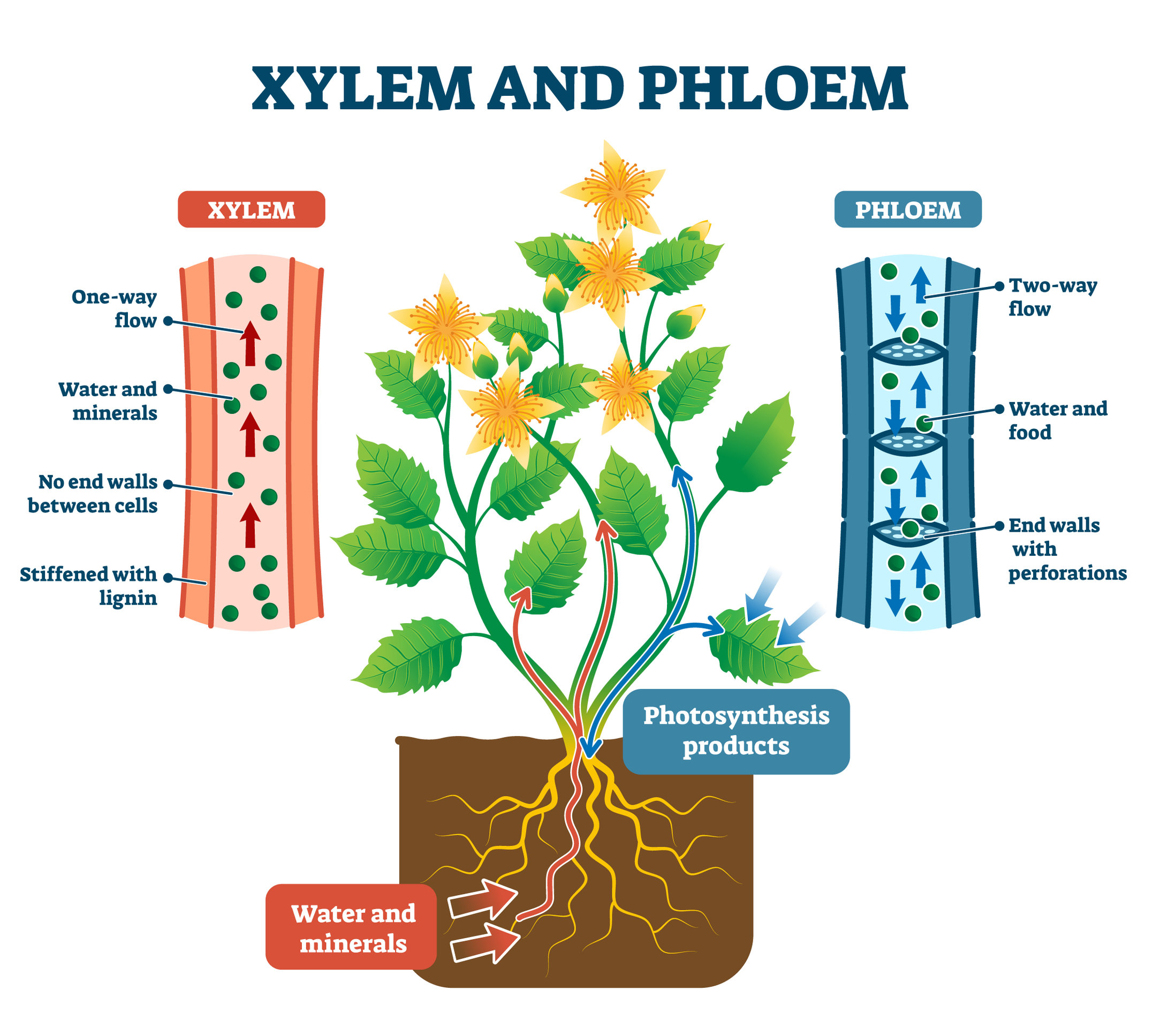The Vascular Symphony: Xylem and Phloem, the Lifeblood of plants
Plants, the silent architects of our terrestrial ecosystems, rely on a sophisticated internal transport system to thrive. This intricate network, composed primarily of xylem and phloem, facilitates the movement of water, minerals, and sugars, ensuring the survival and growth of these vital organisms. Understanding the structure and function of these vascular tissues is crucial to appreciating the remarkable adaptations that enable plants to conquer diverse environments.
1.1. Structure of Xylem: A Network of Pipes
Xylem, the primary conduit for water and dissolved minerals, is characterized by its unique cellular architecture. The principal conducting cells, tracheids and vessel elements, are specialized for efficient water transport. These cells undergo programmed cell death at maturity, leaving behind hollow, interconnected tubes that form a continuous pathway from the roots to the leaves.

Tracheids: These elongated, spindle-shaped cells possess thick, lignified secondary cell walls, providing structural support. Their ends overlap, and water moves between them through pits, small thin areas in the cell wall.
The lignified cell walls of xylem provide essential mechanical support, enabling plants to grow tall and withstand environmental stresses. Additionally, parenchyma cells, living cells interspersed within the xylem, contribute to storage and lateral transport.
1.2. Mechanism of Water Transport: The Transpiration-Cohesion-Tension Theory
The ascent of water in xylem is driven by a combination of physical forces, collectively known as the transpiration-cohesion-tension theory.
Transpiration: The evaporation of water from leaf surfaces creates a negative pressure potential, or tension, within the leaf tissues.

This passive transport mechanism, driven by the sun’s energy, allows water to ascend to great heights, even against the force of gravity.
1.3. Mineral Transport: A Vital Component
In addition to water, xylem also transports dissolved minerals absorbed from the soil. These minerals, essential for plant growth and development, are carried along with the transpiration stream. The concentration of minerals in the xylem sap varies depending on the availability of nutrients in the soil and the plant’s physiological needs.
2.1. Structure of Phloem: A Network of Sieve Tubes
Phloem, the primary conduit for sugars and other organic compounds, is composed of living cells, unlike xylem. The principal conducting cells, sieve tube elements, are specialized for the transport of phloem sap, a sugary solution.
Sieve Tube Elements: These elongated cells are connected end-to-end, forming long, continuous tubes called sieve tubes. Their end walls, known as sieve plates, are perforated with pores that facilitate the flow of phloem sap.
Phloem also contains parenchyma cells and fibers, which provide storage and structural support.
2.2. Mechanism of Sugar Transport: The Pressure-Flow Hypothesis
The movement of phloem sap is driven by a pressure gradient, as described by the pressure-flow hypothesis.
Source: Sugars are produced in source tissues, such as mature leaves, through photosynthesis. These sugars are actively loaded into sieve tube elements, increasing the solute concentration and lowering the water potential.
This active transport mechanism, driven by metabolic energy, allows sugars to be transported to all parts of the plant, regardless of gravity.
2.3. Diverse Cargo: Beyond Sugars
Phloem sap is a complex mixture containing not only sugars but also amino acids, hormones, minerals, and other organic compounds. These substances are essential for plant growth, development, and defense. Phloem also plays a crucial role in long-distance signaling, allowing plants to coordinate responses to environmental stimuli and internal cues.
Xylem and phloem work in concert to ensure the efficient transport of essential substances throughout the plant. Their functions are interconnected, and their activities are tightly regulated.
3.1. Water Balance: A Shared Responsibility
The transpiration stream driven by xylem transport is essential for maintaining water balance in the plant. Phloem relies on the availability of water from the xylem to generate the pressure gradient necessary for sugar transport. The movement of water between xylem and phloem is carefully regulated to maintain turgor pressure and prevent dehydration.
3.2. Nutrient Allocation: A Coordinated Effort
Xylem and phloem collaborate to allocate nutrients to different parts of the plant. Minerals absorbed from the soil by the xylem are transported to leaves, where they are used in photosynthesis. The sugars produced in leaves by phloem are then transported to roots, where they are used for growth and storage.
3.3. Defense Signaling: A Unified Response
Phloem plays a crucial role in transmitting defense signals throughout the plant. When a plant is attacked by a pathogen or herbivore, phloem sap can carry signaling molecules that activate defense responses in distant tissues. Xylem can also transport defense compounds, such as phenolic compounds, to infected or damaged areas.
Plants have evolved a variety of adaptations in their xylem and phloem to thrive in diverse environments.
4.1. Xerophytes: Adapting to Arid Conditions
Plants that live in arid environments, known as xerophytes, have evolved adaptations to minimize water loss. These adaptations include:
Thick cuticles to reduce transpiration
4.2. Hydrophytes: Adapting to Aquatic Environments
Plants that live in aquatic environments, known as hydrophytes, have evolved adaptations to maximize water uptake and gas exchange. These adaptations include:
Reduced xylem tissue
4.3. Halophytes: Adapting to Saline Environments
Plants that live in saline environments, known as halophytes, have evolved adaptations to tolerate high salt concentrations. These adaptations include:
Salt glands to excrete excess salt
Xylem and phloem, the vascular tissues of plants, are essential for the transport of water, minerals, and sugars. These intricate networks enable plants to thrive in diverse environments and play a crucial role in maintaining the health and productivity of our ecosystems. Understanding the structure and function of xylem and phloem is essential for appreciating the remarkable adaptations that allow plants to conquer the challenges of life on land. As we continue to explore the complexities of plant biology, we gain a deeper understanding of the vital role that these vascular tissues play in the grand symphony of life.
